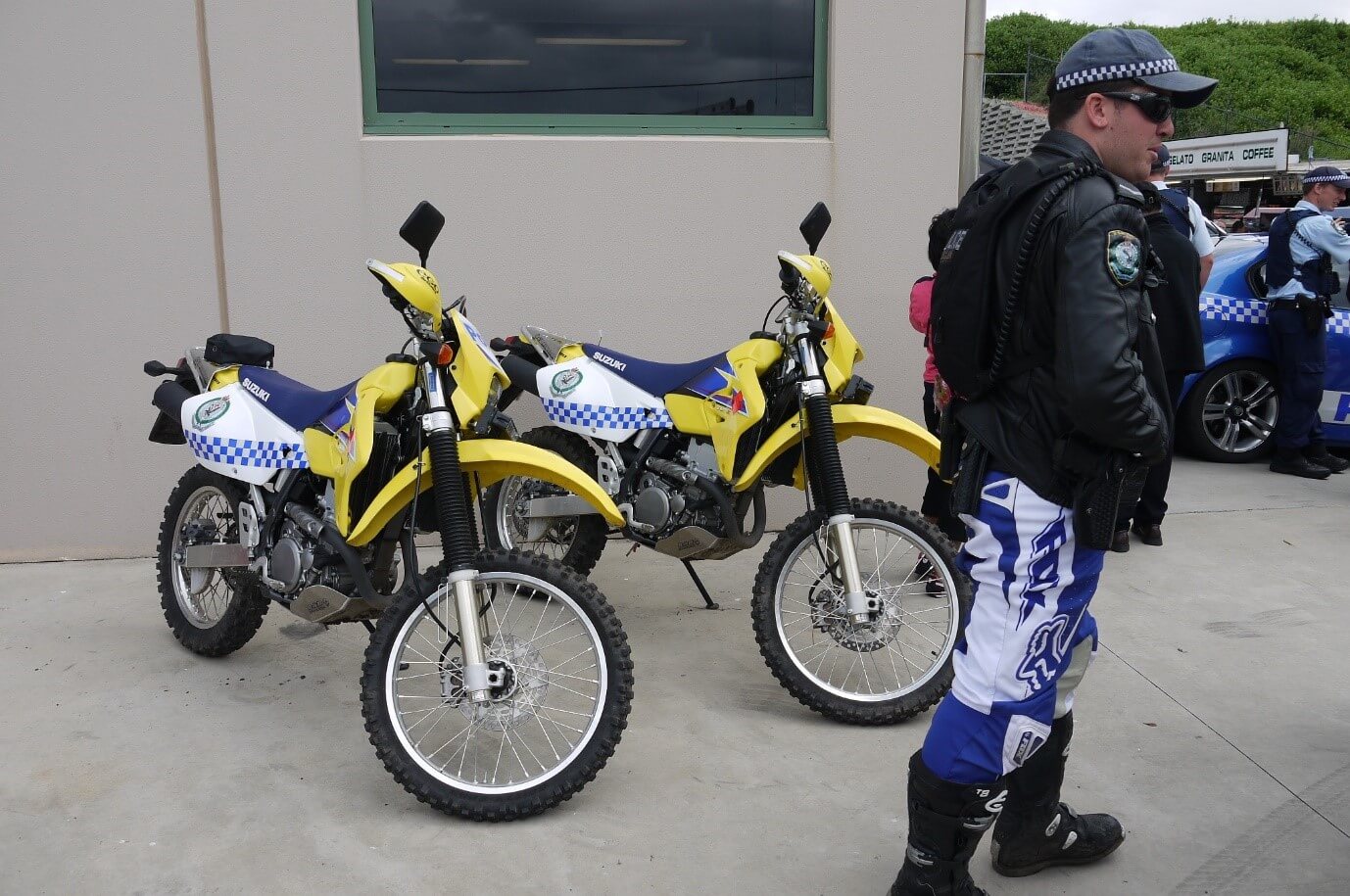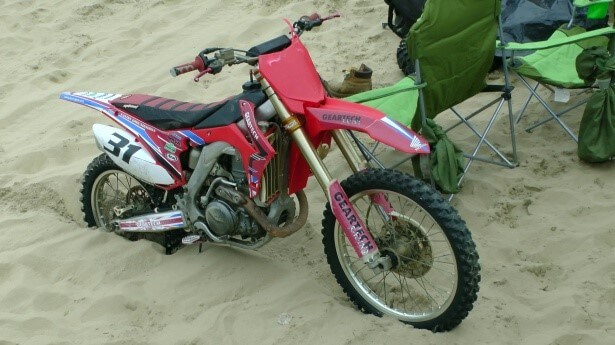Types of Dirt Bikes
If you are a dirt bike enthusiast, or are planning to lay your hands on your first dirt bike, you probably would like to know the various kinds of bikes available to us in the Dirt Bike arena.
It also depends on your end goals. Are you just planning to be an amateur driver, or are you planning to be a professional in a certain kind of race (called Discipline).
This is what we aim to do in this article. We will mention the various types of dirt bikes and their main features.
 Table of Contents
Table of Contents- Are you a beginner or a pro?
- Two Stroke or Four Stroke Engine
- Disciplines in Dirt Bike racing
 Snapshot of the types of Dirt Bikes
Snapshot of the types of Dirt Bikes- Trail dirt bikes
- Race dirt bikes – e.g. Motocross bike, Enduro bike.
Engine power that you will often find in dirt bikes: 125 cc, 140 cc, 200 cc, 230 cc, 250 cc, 300 cc (even upto 750 cc)
Most famous companies manufacturing dirt bikes: Yamaha, Kawasaki, Honda.
There are a few less known categories of dirt bikes too:
- Trials dirt bikes or Observed Trials (they are different from Trail bikes)
- Supermoto dirt bikes – they have street wheels and so it’s legal to ride them on roads.
- Hill climb dirt bikes
- Flat track dirt bikes
There are a few parameters that you need to keep in mind while purchasing a dirt bike.
Are you a beginner or a pro?
We generally recommend Trail Dirt Bikes for beginners, while pros often go for Race Track Dirt bikes.
Trail Dirt Bikes
These are the most common and the cheaper kind of dirt bikes. It is often the first bike of teenagers. So, Trail Dirt Bikes are entry-level bikes is the world of dirt bikes. If you are a new rider, these are the bikes you should go for.
If you are the inquisitive kind, then here are the reasons behind these bikes being beginner-friendly:
- They are easier to control
- Their height is less – almost 5-6 inches less than a Race Track Dirt bike. This also makes them easy to control. So, a 5 feet 2 inches to 5 feet 8 inches rider can easily ride these bikes. If you are taller though, these bikes may feel miniature. Take a bike that allows you to place both feet on ground easily.
- Most of them have air-cooled engine and a little less suspension. So, less maintenance. Air-cooled engine produces less power/torque, which can easily be managed by a new rider.
As a new rider, you are looking for safety and harm mitigation. These bikes are not only safer for new riders, you will not feel very bad if they get scratched or partially destroyed. You may even explore the option of buying used bikes. You will easily find used dirt bikes on the internet.
Hone your riding skills on these bikes, before you move on to more expensive category.
Race Track Dirt bikes
These bikes are for the more advanced (and taller) riders. Obviously, they carry more power and oomph. And are more expensive for certain!
If you are planning to be a professional dirt bike racer, then these are the bikes you should upgrade to, once you feel you are ready.
How to differentiate Race Track Dirt bikes from Trail Dirt Bikes?
You can easily differentiate these Race Track Dirt bikes from the Trail Dirt bikes.
- In Trail Dirt bikes the fork is more conventional, i.e. the upper part of fork is smaller than the lower part. On the other hand, in Race Track Dirt bikes the upper part of fork is larger than the lower part.
Trail Dirt bikes:
Race Track Dirt bikes:
- Most Trail Dirt bikes have air-cooled engine. So, there will be no radiator behind the fins. You will almost always find a radiator in case of Race bikes.
Now, there’s another distinction we need to make while purchasing any category of dirt bike.
- How powerful an engine you want – more the cc, more the power. Well, that’s easy.
- Whether to go for two-stroke or four-stroke engine?
Two Stroke or Four Stroke Engine
You will find both two-stroke and four-stroke dirt bikes in the market. Two-stroke technology has been around since long. It’s the old technology. While, four-stroke engine is the new kid around the block.
So, let’s compare these two.
Weight of the bike
Four stroke bikes are heavier and so feel more stable. Though these bikes are getting lighter every year and getting close to the weights of two-stroke bikes.
Sound of the bike
Many people find riding a two-stroke bike more fun. That’s because it’s lighter and makes cooler noise. The sounds a bike produce may be a big thing for many motorbike enthusiasts (including me).
Maintenance headaches
Two stroke bikes are much less complicated and so easier to work on. Four stroke bikes are way more complicated. So, if you are not very mechanically inclined, do not try to get your hands dirty with critical components of a four-stroke bike. A little mistake on your part may create a lot of mess.
Though their day-to-day upkeep is pretty similar – changing oil, filters, etc.
Fuel
You can just pump in regular fuel in a four-stroke bike. However, in case of two-stroke bikes we need to mix it up. If you forget to mix the fuel in your two-stroke bike, it may blow. There have been thousands of such cases, wherein people forgot to put in proper fuel in their two-stroke bikes and ended up paying the price.
Beginner Vs. Pro
Two stroke bikes are easier to manage and hence often chosen by first-time bikers. However, if you are looking to take part in a race, then you should probably prefer a four-stroke bike, as they can provide you that extra speed edge and they are a bit more stable at higher speeds.
Terrain / Track
Four-stroke bikes are a jack of all trades. They will do just fine on any kind of track – soft or hard.
Two-stroke bikes perform the best if you are driving on soft, loamy, thick dirt. That is, the kind of dirt where the wheels can get some grip. They do not perform that well on hard pack dirt tracks. It’s harder to create traction on such tracks and these bikes do tend to slide on such stretches. So, sharp turns become a challenge.
So, in short, if you are a beginner or are just looking for fun ride, go for a two-stroke bike – easier to maintain, makes awesome noise, etc. Otherwise, go for a four-stroke.
Now, let’s have a look at the different Disciplines we have in Dirt bike racing. If you are aiming to become a professional dirt bike racer in the long run, then you will have to choose the kind of races you like more and suitable bikes that will give you an edge.
Disciplines in Dirt Bike racing
Motocross
Dirt bike racing held on enclosed off-road circuits. So, there’s an enclosed circuit and racers take a few laps.
Here, you should go for faster and lighter dirt bikes. Bikes used in such races do not have a big gas tank, as these are not ridden for long (generally a maximum of 20 to 30 minutes at a time).
Cross-Country
It’s a longer race across the countryside. The trail along which you need to ride is already set. It may take you 1 to 2 hours to complete a lap in such races.
It’s more of an adventure than racing and many people enjoy it more than going round and round in an enclosed track.
Dust bikes that participate in cross-country race need to have a larger gas tank. That’s because:
- You are going to ride for long distances and it won’t be convenient to refill again and again. Sometimes, you will ride for hours at a go, before taking a break.
- Some stretches may really be a lot off-road, far away from human inhabitation. You don’t want to get stranded in such stretches in want of fuel, do you?
Enduro
Here also, you ride for long distances, and not just in a closed loop. However, the trail may not be completely across woods. You may have to ride on roads too for some part of the race, e.g. to go from one check point to another.
Enduro bikes also need to have a large gas tank, just as Cross-Country dirt bikes do. The reason is also the same – long distance travel with few breaks.
However, Enduro dirt bikes also need to have a headlight. While it may not be the case with Cross-Country dirt bikes. That’s because Cross-Country dirt bike race is done on a set trail that is off-road. But in case of Enduro racing, riders may have to ride on road for some part of their journey, and so will have to handle traffic. So, these bikes need to be more conventional and road-safe.
We can say that, Enduro bikes are somewhere in between Trail bikes used by amateurs and Motocross (MX) bikes used by pros. You may consider them the race versions of Trail bikes that have some features of Motocross bikes installed in them, such as a more powerful engine.
 Note
NoteThe above three categories are the broad categories. There are many other sub-categories and other minor categories. For example, we have Motocross (MX), Supercross (SX), Arenacross (AX), Enduro (GNCC), Endurocross, Trials, Hare Scrambles, Hare & Hounds, Hill Climbs, Ice Races, Freestyle (FMX), etc. We will study them in much more detail in a separate article.
